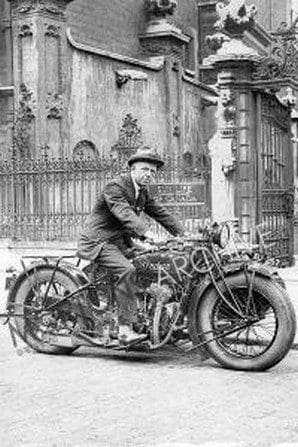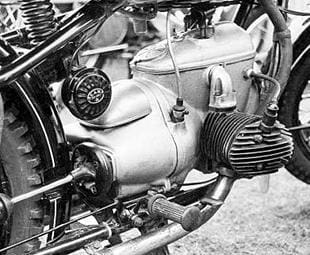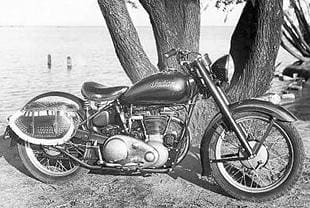
IFA 1945/49-60 Germany
Shaft drive as fitted by IFA, is common on German motorcycles. The town of Zschopau in Saxony was the centre for advanced two-stroke development during the inter-war years. Young Danish born engineer Jorgen Stafte Rasmussen established his company in Zschopau during 1919, adopting the initials DKW for the motorcycles his company was to produce. The firm pioneered pressed steel frame construction with the 1925 SM model, loop scavenge two-stroke design in 1929 and a form of supercharging for their GP winning but noisy racers during the Thirties.
After WWII, the Zschopau plant was in ruins. While some buildings remained, the factory had been gutted. Complete motorcycles, machine equipment, spare parts and even electrical fittings were sent east to the Soviet Union. The factory was to be demolished, but then the order was given in 1945 for motorcycle manufacture to restart at Zschopau. Initial production – centred around assembling motorcycles from surviving spares – started in 1946, and the machines were exact copies of the DKW RT125.
By 1949, full scale motorcycle manufacture was under way and the controlling company IFA – Industrieverwaltung Fahrzeugbau – was founded. Production was based on the IFA RT125, /1 and /2 variants, of which 63,347 had been built before 1957. Soon, 123cc IFAs were tuned for racing by private enthusiasts like Daniel Zimmerman (for Horst Fugner) and then the father figure of racing two-stroke preparation, Walter Kaaden. Zimmerman employed his own patented rotating disc valve for the 123cc engine, which immediately began developing over 2hp more than IFA’s own racing models.
 Impressed by Kaaden’s work, IFA appointed him to run the factory race team in 1953 and within a year, using the Zimmerman disc valve and his own primitive form of expansion chamber in place of an open megaphone, Walter Kaaden had upped power output to 13hp. By 1961, the 125cc racer had become an MZ and Kaaden’s baby was developing 25hp, so becoming the first engine in the world to hit the magic target of 200hp per litre.
Impressed by Kaaden’s work, IFA appointed him to run the factory race team in 1953 and within a year, using the Zimmerman disc valve and his own primitive form of expansion chamber in place of an open megaphone, Walter Kaaden had upped power output to 13hp. By 1961, the 125cc racer had become an MZ and Kaaden’s baby was developing 25hp, so becoming the first engine in the world to hit the magic target of 200hp per litre.
While the lightweight DKW copies were selling briskly, IFA saw a market niche for larger capacity motorcycles, leading to the launch of the BK350 for the 1952 season. The machine resembles a shaft drive BMW flat twin, but a two-stroke barrel protrudes from each side of the engine, looking as if it has been been robbed from a DKW RT125 or BSA Bantam D1.
IFA briefly tried the motor scooter market with its 125cc Rico-Roller. It was essentially a DKW/IFA derived 123cc engine, mounted in a strange looking chassis, which looked part cycle, part motorcycle and part scooter with 19in wheels, rear suspension and huge all enclosing metal bodywork. The kind could regard it as a scooter, while the unkind liken it to an armour clad horse ready for a jousting tournament.
Although production of the IFA marque continued until 1960, the factory had begun using the name MZ – Motorraderwerke Zschopau – first for machines from the newly founded race shop in 1953 and later for roadsters. Although the name MZ was in universal use for all models from 1960, the initials IFA were seen occasionally in later years emblazoned on the tanks of selected off-road models.
For the dedicated two-stroke fan, an IFA is an essential addition to any collection. While the RT125 performs like the corresponding DKW or BSA Bantam D1, the BK 350 is an altogether different experience, combining big motorcycle shaft drive technology with a smooth flat twin two-stroke engine. Mechanical spares can be sourced from German specialists.
Ilo 1923-25 Germany
Well respected maker of two-stroke proprietary engines from Pinneberg, who first built 117-170cc lightweight two-stroke motorcycles but soon ended production to concentrate on supply of engines alone.
 Imme 1948-51 Germany
Imme 1948-51 Germany
An innovative design by Norbert Riedl, comprising a high revving 99cc three-speed, two-stroke engine joined to the rear wheel by the exhaust pipe, which also acted as a single sided pivot member for the rear suspension. Unsurprisingly, the front fork was single sided too. Despite winning much acclaim, Imme sales were slow, though examples do survive – including some here in Britain.
Before Riedl Motoren of Immenstadt closed their factory doors, they unveiled a 148cc twin cylinder version, which was made in very limited numbers.
IMN 1950-58 Italy
Industria Meccanica Neapolitana of Naples made torpedoes for the Italian navy before and duringWWII. Like many rival Italian engineering firms, they were without work at the war’s end and considered motorcycle manufacture. By 1950, they had begun full scale production, developing a range of 49-248cc two-stroke motorcycles.
At the 1956 Milan Show, IMN sensationally unveiled the Rocket, comprising a 199cc ohv flat twin cylinder engine with bolt-up gearbox, shaft drive and a semi trellis frame. Unfortunately, the concept wasn’t fully developed, proved unreliable and was costly to manufacture, leading IMN to end motorcycle production in 1958. They also built smaller ohv singles with trellis type frames, but again sales were slow. Occasional IMN two-stroke motorcycles have been imported into the UK recently by specialists.
Imperia 1924-35 Germany
Splendid JAP, Blackburne and MAG engined singles and V-twins built by Becker Imperia of Cologne. In 1926, the firm filed for bankruptcy but was saved and taken over by the Schrodter family of Bad Godesburg. Production continued as before but other engines, including the Rudge Python and Bark were used too. Imperia enjoyed much national racing success but production was badly hit during the mid-Thirties when the Hitler led government made it near impossible to import foreign engines into Germany. Rolf Schrodter hit back with a range of unconventional flat twin cylinder, two-stroke engines including a supercharged model. Sadly cash ran out and Imperia closed.
The Becker and later Schrodter Imperia factory had no connection with either the Italian concern or rival German firm of the same name who briefly installed JAP engines in open frames during the mid-Twenties. Imperia 1932-55 Italy Turin factory run by Enrico Torelli who began motorcycle manufacture installing JAP and New Imperial engines in English-like machines. Enrico developed his own 500cc ohv single in 1939 and added an ohc model to his limited range in 1954.
 Indian 1901-53 USA
Indian 1901-53 USA
Many, many fledgling motorcycle makers failed through poor design, market research, standards of manufacture or bad management. But not Indian. The partnership of George Hendee and Oscar Hedstrom was initially a marriage made in heaven. Hendee understood business management and marketing, while Hedstrom became a leading designer of his period.
Although Hedstrom retired in 1913 and Hendee in 1916, these two men gave Indian a head-start in the motorcycle business. Both had roots in cycling. Riding ordinary cycles (penny farthings), George Hendee won five One Mile Amateur Championships as well as Championships at two, five and 10 miles. Between 1883-1891 he secured 302 wins from 309 entries before retiring in 1895 to start bicycle manufacture. Hedstrom, a toolmaker by profession, also raced cycles, but was becoming noticed for the De Dion powered cycle pacers he built in partnership with Mr Henshaw. While rival products stuttered round the cycle track, the Hedstrom-built machines could maintain even speeds reliably and increase or decrease pace at will.
By 1900 George Hendee – who sponsored cycle racing for both personal and business reasons – heard of the Hedstrom cycle pacers, a necessity for setting new world records. Hendee persuaded Hedstrom to bring a cycle pacer to the track at Springfield, Massachusetts and was impressed by its smooth, consistent performance. In January 1901 George commissioned Oscar to build a road going motocycle*. Four months later Hedstrom delivered what was later to be called the first Indian by riding it the 40 miles from Middletown, Connecticut to Springfield.
Hedstrom’s first machine wasn’t just a clip-on fixed to a sturdy cycle frame, but a specially designed motorcycle in which the engine formed a frame stress member sited in place of the saddle down-tube. The model sported a tank over the rear wheel, a feature of early Indians which became known as ‘camel backs.’ In 1904 Indian introduced twist grip control with rod instead of cable operation – albeit for ignition advance/retard – and later in the year began building V-twins, although these weren’t catalogued until the 1907 season. In keeping with then current Indian design the rear cylinder was a frame stress member.
The loop frame appeared for 1909, freeing the engine from its frame member role, but the design had been used at least three years earlier for race machines including the model (based on the original pacer) Hedstrom took to a one mile record at 57mph. Not only were designs advancing but Indian sales climbed steeply, 1905 : 1181, 1908 : 3257 and 1913 : 32,000, although they did slump somewhat immediately after this date.
In 1907, Teddy Hastings became the first American aboard an American machine to compete in Britain in the Thousand Mile Trial. In 1909, Billy Wells, a Brooklands racer aboard a Vindec Special, switched to Indian and also became London distributor for the firm. Guy Lee Evans raced an Indian at Brooklands and also finished second in the 1909 TT. Indian’s finest hour in the Island came two years later, however, with a clean sweep for Oliver Godfrey, Charlie Franklin and Arthur Moorhouse, all of whom also enjoyed Brooklands success. Flamboyant American Jake de Rossier had shaken the Brooklands coterie by packing over 84 miles in to an hour in February 1911 to start ‘The Indian Summer.’ Some were sceptical, but later in the year de Rossier went even faster for an ‘official’ time-keeper.
 Roadster production of singles and V-twins continued. Models were built for many forms of competition including board racing and in 1912 came the first eight-valve racers – V-twins with four valves per cylinder. Then, for 1913, came Indian’s first kick-start models (earlier machines used pedals), knock out wheel spindles and swing arm suspension controlled by leaf springs. The electric start Hendee Special appeared in 1914.
Roadster production of singles and V-twins continued. Models were built for many forms of competition including board racing and in 1912 came the first eight-valve racers – V-twins with four valves per cylinder. Then, for 1913, came Indian’s first kick-start models (earlier machines used pedals), knock out wheel spindles and swing arm suspension controlled by leaf springs. The electric start Hendee Special appeared in 1914.
If much of the veteran period can be regarded as the time of the Indian F-head (inlet-over-exhaust valve) then the vintage period saw the dawning of the side-valve era with the launch of the Powerplus Model F for the 1916 season. Also for 1916, Indian briefly flirted with their Featherweight two-stroke, and then the following year came the fore-and-aft Model O Light Twin. The 350cc single cylinder side valve Prince was introduced in 1925, which looked more like a British lightweight than an American product.
During the Twenties, Indian unveiled some great motorcycles including the 37cu in/600cc Scout (1920) which became with its later larger brother a great favourite of wall of death riders (and still is), 61cu in/1000cc Chief (1922), 74cu in/1200cc Big Chief, 45cu in/750 Scout (1927) and Indian Ace (1927) following the purchase of four cylinder Ace tooling and rights.
Despite the efforts of management teams which had followed Hendee’s retirement in 1916, the Scout, Chief and Prince became more styled and gained an ohv cousin. After diversifying into non-motorcycle products (outboard motors, refrigerators, shock absorbers…) Indian was still in serious trouble by 1930. As a result of a series of deals and the departure of some key staff, the business was taken over by financier E Paul du Pont.
Indians introduced new models, including the Dispatch Tow (later restyled and renamed the Dispatch Car) commercial three wheeler with load trunk mounted between the rear twin wheels, and the Scout Pony V-twin, of which many early models were built using left over Prince parts. Additionally, old favourites including the fours, Scout and Chief ranges were revitalised. Despite this enthusiasm, Indian continued to teeter on the verge of bankruptcy. Pay cuts, cost cutting, lay-offs and short time working were key phrases for the company.
 Indian survived the depression years thanks in part to the skills of general manager Joe Hoslkey, the buyers who kept faith with Indian and du Pont’s ability to dip in his own pocket occasionally. Rollie Free went record breaking – keeping his leathers on for the time being! – Al Chasteen, Albert Westerberg, Woodie Castonguay et al went racing, while the models 741A-initially designated 640A (493cc), 741B-initially designated 640B (744cc), 340 (1204cc) and 841 (744cc) joined the allied war effort. The 841 shaft drive transverse V-twin was abandoned after a tad over 1000 had been supplied.
Indian survived the depression years thanks in part to the skills of general manager Joe Hoslkey, the buyers who kept faith with Indian and du Pont’s ability to dip in his own pocket occasionally. Rollie Free went record breaking – keeping his leathers on for the time being! – Al Chasteen, Albert Westerberg, Woodie Castonguay et al went racing, while the models 741A-initially designated 640A (493cc), 741B-initially designated 640B (744cc), 340 (1204cc) and 841 (744cc) joined the allied war effort. The 841 shaft drive transverse V-twin was abandoned after a tad over 1000 had been supplied.
Joe Hoslkey died in 1940 and E Paul Du Pont seemed to lose enthusiasm for the project. After a few hiccups, the Du Pont brothers sold their share in the business and a consortium headed by Ralph B Rogers, who was convinced European style parallel twins would see an upturn in sales, eventually took control. Development work on a range of modular design 220cc single/440cc twins and 880cc fours, developed from a design by G Briggs Weaver, led to a range of vertical single and twin cylinder models which proved fragile. At least the Chief remained in production for the time being and a special batch of V-twin Scouts was made too.
On the racing front Indian fortunes dwindled in favour of British singles and twins and the Harley WR750. Indian control passed to the British Brockhouse concern who were responsible for the Papoose (Corgi) and Brave (Brockhouse Brave) while a dribble of Chiefs continued for a few more years. In 1954, Indian dealers offered Royal Enfields, which became Indians a year later, then in 1960 AMC used the Indian marketing network. The brand passed through a number of hands including Floyd Clymer. Eventually, Canadian clothing magnate (T-shirts and Indian badged clothing) Murray Smith (CMC) gained control of the marque and the first small batch of V-twin Indian style motorcycles appeared in 1999.
Like other cult marques, Indian ownership is both a statement and a way of life. Meets, help and enthusiasm abound, many spares are available and, if they are not, you could well find someone who will make them, but initial purchase of the V-twins, in-line fours and early models needs a serious bank balance.
* Motocycle. In 1895 Frank Duryea won a road race for self-propelled machines sponsored by the Chicago Times Herald. As a spin off from the race the newspaper ran a competition to rename the ‘horse-less carriage.’ The word ‘motocycle’ was judged winner, George Hendee liked the word so Indians made motocycles not motorcycles.


